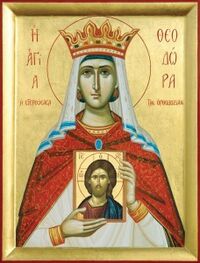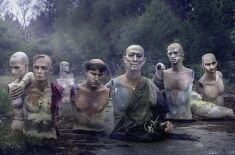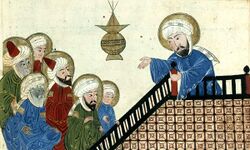Iconoclasm
Iconoclasm is the belief that there should be no permanent heroes, that all the icons should be ripped down, all the sacred cows turned into beef burgers. Whereas vandalism is usually 'mindless', iconoclasm is regarded as a reflection of God's will.
It stems from Moses and his Ten Commandments — to whom God had clearly said, 'Don't worship blocks of stones or forests of trees; believe only in Me' — which is why to this day you never see a painting of Moses in a synagogue or a mosque.
Though the monotheistic Christians grandfathered in the same principle, they built a persistent love-hate relationship with it. In the 8th century, Byzantine emperor Leo III sought to return the Empire to its Biblical roots, forbidding the worship of God and Jesus by way of pictorial representation or 'icon'. Those who clashed with icons were termed 'iconoclasts' — or, in the Latin West, 'idol-smashers' and 'image-breakers'.
Biblical origins
Iconoclasm traces its roots to about a millenium and a half before Jesus, when the Children of Israel took the Exodus 19 to Mount Sinai Hospital. There they "heard the voice of the trumpet exceeding [sic] loud" and sent Moses upstairs to ask the land Lord if He could do something about the neighbors. Before He would do any such thing, the Lord insisted on a formal lease. The Super is always a stickler when He wants to be, and so He carved the terms into stone tablets. It is right there in Number Two (sometimes Number One), "Thou shalt not make unto thee any graven image." Iconoclasm was born.
However, by the time Moses got back down to the flat, the other tenants had already fashioned a golden calf. Moses, realising the Lord would have kittens, broke the tablets (for effect). The tenants ditched their bovine icon and Moses carved a new set of tablets, entirely from memory, ad-libbing only a little.
From that point on, Judaism took a clear position regarding sticking up statues: Don't. Hell, their coinage didn't even remind you who the current Chief was. Like you could forget? When the great Temple of Jerusalem received donations, a team of middlemen exchanged it for 'faceless money'[1] actually dropped in the coffers — inventing banking.
The Jews rebelled against the Greek Seleucid rulers of their country in the second century BC, after Antiochus IV presumptuously installed a statue of Zeus in the courtyard of the Temple. The Jews eventually prevailed.
The Romans were no less rude about what they thought of Judaism. Roman general Pompey took the city in 63 BC. Amongst the customary looting, Pompey broke into the inner sanctum of the Temple, expecting to see a statue of Yahweh. He was instead shown an empty chair and was told God preferred to stay invisible. Lacking a magic ring, Pompey left puzzled but told his friend Julius Caesar that the peculiar Jews worshipped thin air.
The Jews retained their aversion to creating anything that resembled a man or a living creature, though some broke this rule to appease the Romans and to fit into society. The Christians initially followed the rule, concerning God and Jesus, but relented somewhat after evangelists converted former image worshippers. The rule eventually was discarded when Christians began drawing fishes to distinguish themselves from pagans. The pagans, for their part, instead drew stick figures with the curious legend, 'Kilroy was here'.
Impact of Islam
Once Christianity became the new state religion of the Roman Empire, plucky church leaders recycled much imagery and paintings. So bearded Zeus became a fungus-faced God, whilst Jesus was often shown as a clean-shaven man with a shining light coming out of his head, à la Apollo. The other former pagan deities were portrayed as obscure saints for this-or-that. The general excuse for this imagery-use was that the New Testament had lifted the objections to image worship that had so got the Old Testament prophets pulling out their beards and banning make-up for women.[2]
Statues that couldn't be reshaped were removed from the temples and either sold to private collectors or scrapped. Some of the wilder Christians still claimed that this image stuff was in direct opposition of God's law on religious statues. They were dismissed as extremists. Even during the time of the various splits between Catholics, Orthodox, Arians, Nestorians and Monophysites, no one questioned the need of having pretty pictures of Jesus illustrating Bible stories, along with mosaics and paintings to help 'guide people to Faith'.
Then a chap from Mecca said this was all phooey. His name was Muhammed. The Byzantines at first thought Muhammed belonged to one of those oddball Christian sects, with their emphasis on biblical teachings and circumcision. But Muhammed espoused an all-new theology, featuring himself as the Prophet of Last Wordism. This new religion — Islam — started out as a Monotheistic reboot. When the armies of the Caliphate started to conquer and hold on to territories in the Middle East and North Africa, some Byzantines wondered if God and Jesus had deserted them. If they were in charge of a godly state, why were these rebels doing so well? Had the Byzantines pissed off the Almighty?
Leo lays down the law
Byzantine emperor Leo — unsurprisingly nicknamed Leo the Iconoclast — saved Constantinople from an Arab army laying siege to the capital in 717-718. He credited God's intervention, but His symphony came with a coda even longer than Hey Jude — The Holy Trinity complained to Leo that the churches were stuffed with idolatry and questionable imagery. The cross could stay, but the rest had to go. In 726, Leo issued an official edict:
| “ | We checked the Bible and it specifically rules out image worship. This was overlooked during the 300-year transition from paganism to Christianity. The process is now finished. No more idols, no more depiction of living things including man, beast, God or insect. I have spoken, this is the law. | ” |
—Basileus Leo, Autokrater, Chariot Mechanic and Protector of Christ | ||
Resistance
The edict applied throughout the Byzantine world and also to the Papacy, where it was immediately opposed — notably, even by Leo's own troops. The resisters were chased out of their jobs, threatened with violence, and occasionally murdered. Leo's dislike of icons was amplified by his take-charge son, emperor Constantine V for Vendetta (pictured). Yet attempts to destroy Rome's large caches of icons were still greeted with a general exposure of nether parts in the direction of Constantinople.
Though plenty of clerics were happy to follow orders and go door-to-door for icons, the laity hid theirs under floorboards, or under tarps in barns. Some were even sent across the border to the caliphate, where the Muslim authority left the Christians free to worship — just as long as they paid a special tax and didn't ring their bells on Sunday.
Both emperor Leo and "V" pursued their anti-image campaign. A special church council was called in Hieria to rubber-stamp the new orthodoxy. Constantine even wrote to the Frankish kings Pepin the Short and Charlemagne the Mangy to align with the Byzantines. The Franks (never working through the arguments about pro-icon and anti-icon) stuck with the papal position. To them, Constantine seemed merely to be creating a civil war, when he already had plenty of foreign wars on tap. Moreover, iconoclasm wasn't winning on the battlefield: They lost Rome when it chose to buy its protection from the Franks from now on against the Lombards.
Another church council
Constantine's son and successor emperor Leo IV was less of an image-basher than his father or grand-dad. But he was reluctant to admit his family had been wrong to adopt iconoclasm as official Byzantine policy. It was left to his wife Irene and their son Constantine VI to attempt to brake the campaigns. As Irene was the official regent for her son, she ended the persecutions and called a new church council to discuss (without murder) the purpose and use of religious iconography. In other words: what should be depicted and what perhaps best left blank.
The Second Council of Nicaea met in 787. The Greeks had to put up with a delegation from Rome smiling and smirking that it was the Papacy that had been right about issue of images whilst those Byzantine clerics who had supported iconoclasm had been very much in the wrong. The iconophiles naturally wanted to be proved right too. They also had a set of new Christian martyrs to venerate, casualties of the iconoclasts.
So iconoclasm appeared to be over. Icons were allowed back into the churches. Iconoclasts survived and clung to their religious justifications. Many just happened to be in the army and were soon pointing out that God abandoned them again when the Byzantines turned icon-friendly. One of the biggest losses was to pride, when Charlemagne was crowned 'Roman Emperor' in 800. The Byzantines thought they had the trademark on the imperial titles.
Second wave
The loss of Imperial face with the Franks was compounded when the Byzantines were crushed (or 'Krumshed') by Krum, Khan of the Bulgarian, in 811. The body of fallen emperor Nikephoros I was turned into a Barbarian dinner service. This eventually led to a successful coup by Leo V. He blamed Byzantine defeats not on lousy leadership but that God was making his divine presence known by actively emboldening the empire's enemies.
So, despite what happened in 787, the new emperor officially restored iconoclasm as state policy. Unlike Leo III, this particular Leo tried (at least in the beginning) a more consensual approach. In other words, join Leo along the same road to a renewal of iconoclasm. Once again, icons were hidden and churchmen dismissed from posts if they disagreed. A special commission of monks were told to look into previous special commissions. They agreed that Leo was right. Iconoclasm went back into full swing.
Though Leo V was eventually murdered, it wasn't because of iconoclasm. His successors Michael II and Theophilos adhered to the new iconoclasm. This time, the martyr count was kept down as a more conciliatory approach. Didn't work. Moreover, claims that iconoclasm gave the Byzantines a military advantage were dispelled by the further loss of territory in the Western Mediterranean (islands like Corsica and Sardinia), the best part of Sicily and finally Crete. All these lands were lost to the image-averse Muslims. Perhaps iconoclasm wasn't such a hot idea.
Byzantine Reversal (again)

“In Byzantium, icon adores you!”
Once again, it took a woman to re-set the Orthodox church. This time, it was the Imperial First Lady Theodora. Like Irene after the death of her husband, Theodora became regent for emperor Michael III in 842. As Michael was not yet making proclamations in his own right (toilet training being a higher priority), Theodora ended the official persecution.
There was remarkable 'reverse ferret'[3] from Byzantine churchman caught still backing iconoclasm. What was orthodoxy yesterday became heresy today. Theodora didn't call for another ecumenical council like the one in 787. No one really wanted to see representatives of the Pope turning up to repeat their message, 'We Told You So — Again'.
Icons were once again brought back but this time there were a few new rules. The use of statuary to depict Jesus, Mary or the saints was discouraged. Holy imagery would be 2D only; the use of perspective, naturalism and anything that showed real people was also out. The Christian West saw this as the Byzantines overcompensating for their previous religious errors and carried on their traditional iconography, though by this time the Latins had also forgotten to do realistic art. This tendency has played out in modern times through animations such as The Simpsons and SpongeBob SquarePants.
Legacy
Christian art dropped iconoclasm and reverted to portraying the Messiah and saints. In the Eastern Orthodox lands, icons that had managed to survive the purges became even more precious. But the notion that you could even ensure a victory by hauling a statue onto the battlefield was broken by the Byzantines, as awful military strategy will out.
In the Christian West, it was carry on as before. Religious icons and religious relics (especially the holy bones of martyrs) became big business. It took a new generation of image-breakers to change this in the 16th century. These were the Protestant reformers, who ranged from those who just wanted to get rid of statues of saints to those — like the Calvinists, who wanted no images at all in their churches — going back to Old Testament reasoning as regards idolatry. To them, Catholics (and Orthodox) were not really fit to call themselves Christians at all.
Today, icons are the province of celebrities, musicians and politicians. All want the status this brings to their marketable value. Sometimes you can get it wrong. The Beatles's John Lennon once claimed he was "bigger than Frankie Valli," which was true figuratively, literary, and in money, but fans of The Four Seasons were angry enough to burn the records of the band from Liverpool. They went full iconoclast on him. Icons can go up and can easily be pulled down, especially if you have friends in the road haulage business.
George W. Bush's brief but interminable gig went iconic with a megaphone in the rubble of the World Trade Center, but veered back to iconoclasm when HumVees pulled over a statue of Saddam Hussein in Baghdad.
Iconoclasm's latest schism is in informatics, with the nerd-dom playing the role of the iconoclasts. Much as a nation's motto is often in a cryptic foreign language, these iconoclasts make their invocations on the command line, from MS-DOS to UNIX, using incantations such as chmod that the boss can't be arsed to remember. They disdain iconophile computer users who require pretty images, pointedly known as "icons," to express their will.
References
- ↑ Not having an emperor's mug on the coin
- ↑ A.K.A. Jezebel
- ↑ The Anglo-Saxons invented the game of 'Ferret Down the Stockings' to pass the long nights of the Dark Ages. It was a test of endurance for both man and ferret.
| Featured version: 13 February 2021 | |
| This article has been featured on the main page. — You can vote for or nominate your favourite articles at Uncyclopedia:VFH. | |







